Scout Lost Chapter Part 8: IHC At War
International Harvester in WWII

The Lost Chapter series is from Jim Allen and John Glancy's book, International Scout Encyclopedia; one so thorough it couldn't all fit into the final cut. Pre-order the second edition, coming August 1, 2020! Join our mailing list for pre-order specials and exclusive content.
For this series, author and historian Jim Allen is sharing extra material with photographs from John Glancy’s extensive collection as well as photographs from the Wisconsin Historical Society.
War often brings the best out of a vehicle manufacturer and the International Harvester Company was no exception. Their contribution to the war effort ran the gamut from torpedoes to tanks. The war would bring with it the first foray of the International Harvester Company (IHC) into production four-wheel drive trucks, first with the M-2-4 one-ton 4x4 used by the Navy and Marines and then with the M-1-4 half-ton 4x4. They would also produce the M-3-4 ton-and-a-half 4x4 as well as two-and-a-half ton 6x4 and 6x6 trucks as well as a number of militarized 4x2 semi-tractors, high speed artillery tractors and many thousands of the ubiquitous armored half-tracks. IHC also built an experimental tank, the T-7, a 1942 project that started out to make an up-gunned light tank, but when it gained too much weight in the process it moved itself into the medium tank category and thus became totally redundant. A total of about 13 were built for tests.
World War II was IHC’s first experience with all-wheel drive. Adding all-wheel drive to any truck wasn’t much of an engineering puzzle but the company had never really seen the need to offer it in the civilian lines. The same could be said for the other light-truck makers. The extent to which all-wheel drive was utilized by the civilian markets was in larger commercial trucks with very specialized tasks. It was practically non-existent in anything below one-and-a-half tons. When it was utilized in light-duty equipment it was done via conversions by companies like Marmon-Herrington. There were a few large truck builders specializing in all-wheel drive, including FWD, Oshkosh, Walter, Duplex, Coleman, and Marmon-Herrington, among a few others. These manufacturers were well-established and supplied the small market for these products. World War II sent all auto and truck manufacturers scrambling onto the all-wheel drive bandwagon.
IHC truck production in WWII was largely earmarked for the Navy and Marine Corps. This simplified parts supply and standardization by feeding all of IHC output to one branch of the military. IHC did not have the capacity to build trucks in the numbers General Motors was capable, but feeding the Navy Department was well within its means. IHC light, medium and heavy trucks were not as numerous as those built by Dodge, Chevrolet, GMC and others, but they were highly regarded by the Soldiers, Sailors, Airmen, Marines, and Coast Guardsmen that used them.
A substantial portion of IHC military truck production was also earmarked for the Lend-Lease program, whereby military equipment was given to allied nations. The Soviet Union, for example, was the beneficiary of a great number of IHC trucks and some of their wartime and post-war trucks were patterned after them.
International’s M-5-6 6x6 trucks, rated at two-and-a-half tons off-road, are worthy of special mention. In most ways that count they were superior to the legendary GMC “Deuce-and-a-Half.” Many experts think they were superior in every way but production numbers. The International M-5-6 was certainly the superior performer, being fitted with the 361 ci Red Diamond OHV engine that out-powered the 270 ci GMC by 17 hp and out-torqued it by 51 lb-ft. The M-5H-6 6x6 was a Marine Corps special built in large numbers (nearly 30,000) and saw extensive use in the Pacific Theater. It used the Hendrickson walking beam rear suspension, something that offered great cross-country travel, as well as the Thornton Locking Differential, a device that would later be known as the Detroit Locker.
IHC would also participate in building the legendary American half-track, but they would be substantially different from the more familiar White, and Diamond-T units. Again it would field a larger engine (450 ci vs 386 ci) but, of vital importance to the crew, it would have welded steel armor versus the bolted types of the other brands. Bolted or riveted hulls had a nasty habit; if a bullet struck on or near a bolt or rivet, the head could be sheared off and the shank punched through into the crew compartment as a lethal missile. It was lethal even if the bullet itself didn’t penetrate. All the above illustrates how IHC was on the cutting edge for the day, even if they weren’t the biggest producer.
 The M-1-4 would be the lightest of a batch of military 4x4s from half to one-and-a-half tons developed by International Harvester beginning in 1940. A 6x6 two-and-a-half ton would also be developed. While typically Binder robust, the half-ton M-1-4 the Navy and Marines would not find particularly useful versus the one-ton M-2-4. Most of the approximately 1,153 built were used as ambulances and converted by Boyertown. The M-1-4 has a 115 in. wheelbase, ten less than its bigger brother the M-2-4. The first M-1-4s used the 214 ci Green Diamond while the later used the 233 ci unit.
The M-1-4 would be the lightest of a batch of military 4x4s from half to one-and-a-half tons developed by International Harvester beginning in 1940. A 6x6 two-and-a-half ton would also be developed. While typically Binder robust, the half-ton M-1-4 the Navy and Marines would not find particularly useful versus the one-ton M-2-4. Most of the approximately 1,153 built were used as ambulances and converted by Boyertown. The M-1-4 has a 115 in. wheelbase, ten less than its bigger brother the M-2-4. The first M-1-4s used the 214 ci Green Diamond while the later used the 233 ci unit.
WHS 111625
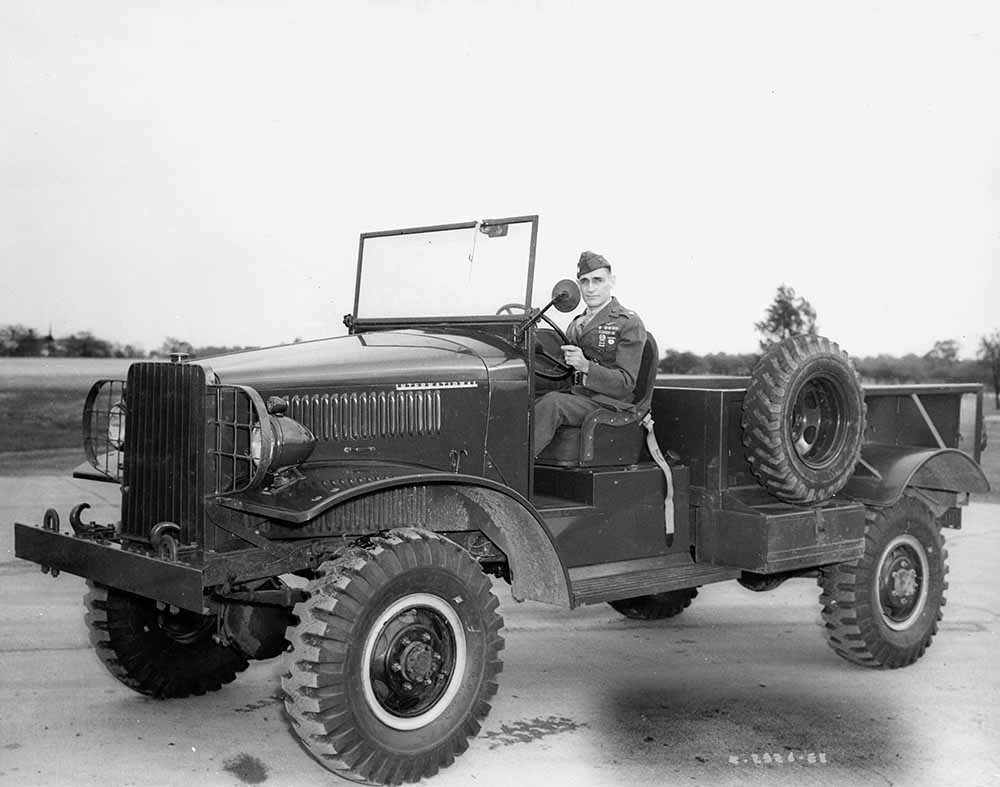
The one-ton M-2-4 was developed and debuted at nearly the same time as the M-1-4 half-ton and soon the Marines saw little need for the lighter-duty truck. The M-2-4 had a longer wheelbase but was scarcely much larger or heavier than the lighter truck, so for the same transportation cubage the Marines got a heavier truck for the money. This beefy truck was highly regarded by the Marines.
WHS 111622
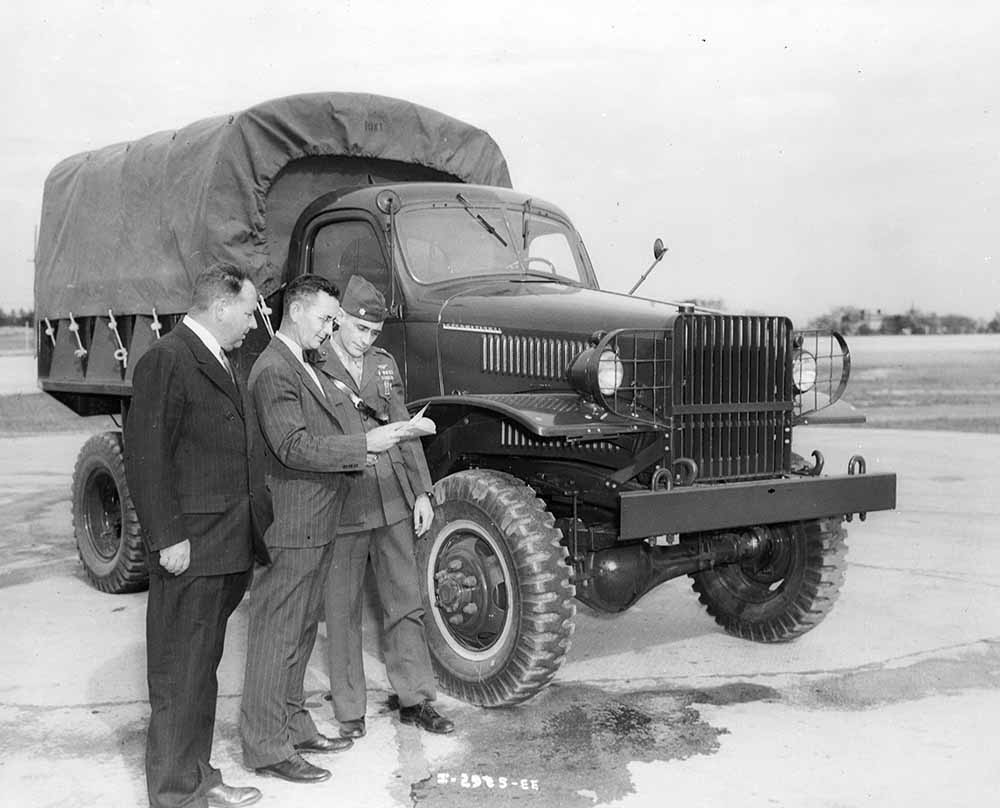
The M-3-4 was the ton-and-a-half version of the WWII International 4x4 family. It was more like the M-5-6 than it was the M-2-4. It used either a 259 or a 269ci OHV six and came in two wheelbase lengths, 139 or 150 inches and in many different configurations. Both open and closed cab models were produced. The M-3-5 closed cab model shown here is the most common of the cargo variants.
WHS 63206
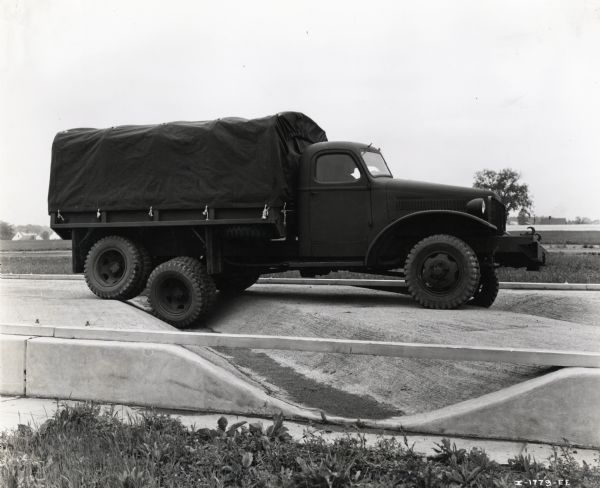
The 2-1/2 ton 6x6 truck was the logistical backbone of America’s ground forces in WWII. They were primarily built by GMC, IHC and Studebaker, each to their own design. The International Harvester M-5-6 (M for military, 5 for 5,000 lbs cross-country capacity and 6 for 6x6) may have been the best of the three, even if it wasn’t the most numerous. In this 1942 image a closed cab (the cab was from the K-Line), long wheelbase M-5-6 is being tested at the Fort Wayne Proving Grounds, and you can see the Hendrickson rear suspension allows plenty of articulation. Many M-5-6 trucks of this general type were sent to Russia under Lend-Lease.
WHS 63206
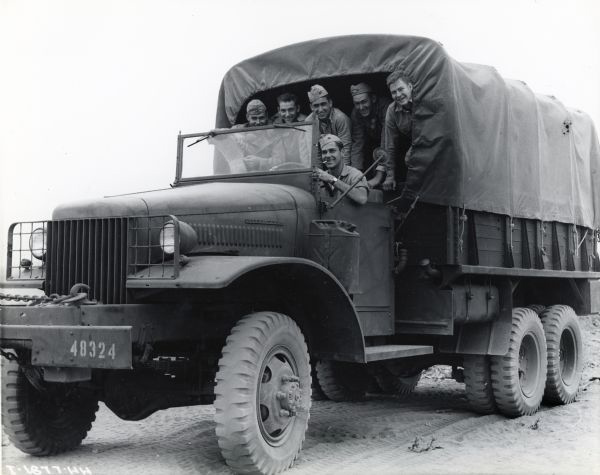
The M-5H-6 was a special-ordered open-cab version of the M-5-6 that used a different rear bed and was fitted with the Thornton Locking Differential in the rear axles, which greatly increased mobility. The USMC also specified a number of smaller changes in the form of lifting rings and such. These were to facilitate loading during amphibious operations, the Marine Corps’ specialty. The IHC M-5H-6 trucks were used by the Marines into the 1950s.
WHS 23475
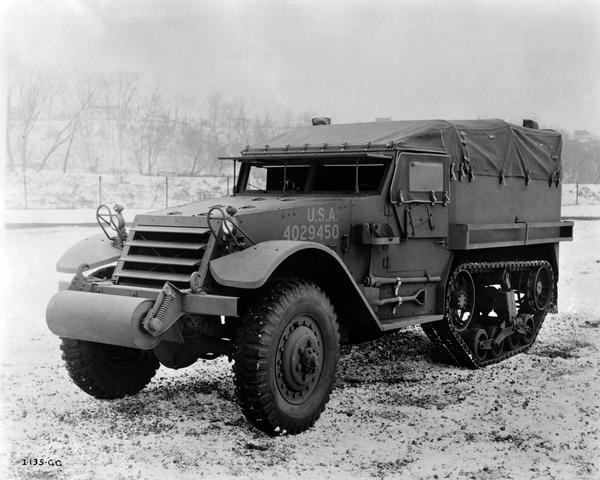
As with the 2-1/2 ton 6x6 truck, the half-track was ubiquitous with allied forces in WWII. They were the standard armored personnel carrier for the US Army and were also used as heavy weapons platforms. In order to have sufficient numbers they were built by a number of manufacturers, White being the originator and primary one, but also Diamond-T, Autocar and IHC. The M-5 half-track was the base IH-built personnel carrier with only one .30-caliber machine gun mounting. The M-5A1 and M-5A2 differed in detail and armament. The International half-tracks had thicker, welded armor plate (5/16-in. versus 1/4-in.) versus the bolted armor built by the other manufacturers. Even with a larger, more powerful engine, the IHC halftrack was a little shower and had worse fuel economy than the others because they were at least 1,000 lbs heavier. With 4,625 built, the M-5 was IH’s most numerous version, but most were shipped overseas for Lend-Lease.
The M-9A1 featured a ring mount for a .50-caliber machine gun as well as three pintle mounts for a .30-caliber machine gun. International built four half-tracks, the M-5, M-5A1, M-9, and M-9A1. The difference between them amounted to armament, internal stowage and personnel capacity. Besides the standardized rear tracks, the IHC half-tracks were very different from the other manufacturers’ and most parts did not interchange. You can tell them apart at a glance by the rounded rear body corners on the IHC and the flat front fenders. Some 1,407 M-9A1s were built.
Previous Lost Chapter-Next Lost Chapter
For this series, author and historian Jim Allen is sharing extra material with photographs from John Glancy’s extensive collection as well as photographs from the Wisconsin Historical Society.
War often brings the best out of a vehicle manufacturer and the International Harvester Company was no exception. Their contribution to the war effort ran the gamut from torpedoes to tanks. The war would bring with it the first foray of the International Harvester Company (IHC) into production four-wheel drive trucks, first with the M-2-4 one-ton 4x4 used by the Navy and Marines and then with the M-1-4 half-ton 4x4. They would also produce the M-3-4 ton-and-a-half 4x4 as well as two-and-a-half ton 6x4 and 6x6 trucks as well as a number of militarized 4x2 semi-tractors, high speed artillery tractors and many thousands of the ubiquitous armored half-tracks. IHC also built an experimental tank, the T-7, a 1942 project that started out to make an up-gunned light tank, but when it gained too much weight in the process it moved itself into the medium tank category and thus became totally redundant. A total of about 13 were built for tests.
World War II was IHC’s first experience with all-wheel drive. Adding all-wheel drive to any truck wasn’t much of an engineering puzzle but the company had never really seen the need to offer it in the civilian lines. The same could be said for the other light-truck makers. The extent to which all-wheel drive was utilized by the civilian markets was in larger commercial trucks with very specialized tasks. It was practically non-existent in anything below one-and-a-half tons. When it was utilized in light-duty equipment it was done via conversions by companies like Marmon-Herrington. There were a few large truck builders specializing in all-wheel drive, including FWD, Oshkosh, Walter, Duplex, Coleman, and Marmon-Herrington, among a few others. These manufacturers were well-established and supplied the small market for these products. World War II sent all auto and truck manufacturers scrambling onto the all-wheel drive bandwagon.
IHC truck production in WWII was largely earmarked for the Navy and Marine Corps. This simplified parts supply and standardization by feeding all of IHC output to one branch of the military. IHC did not have the capacity to build trucks in the numbers General Motors was capable, but feeding the Navy Department was well within its means. IHC light, medium and heavy trucks were not as numerous as those built by Dodge, Chevrolet, GMC and others, but they were highly regarded by the Soldiers, Sailors, Airmen, Marines, and Coast Guardsmen that used them.
A substantial portion of IHC military truck production was also earmarked for the Lend-Lease program, whereby military equipment was given to allied nations. The Soviet Union, for example, was the beneficiary of a great number of IHC trucks and some of their wartime and post-war trucks were patterned after them.
International’s M-5-6 6x6 trucks, rated at two-and-a-half tons off-road, are worthy of special mention. In most ways that count they were superior to the legendary GMC “Deuce-and-a-Half.” Many experts think they were superior in every way but production numbers. The International M-5-6 was certainly the superior performer, being fitted with the 361 ci Red Diamond OHV engine that out-powered the 270 ci GMC by 17 hp and out-torqued it by 51 lb-ft. The M-5H-6 6x6 was a Marine Corps special built in large numbers (nearly 30,000) and saw extensive use in the Pacific Theater. It used the Hendrickson walking beam rear suspension, something that offered great cross-country travel, as well as the Thornton Locking Differential, a device that would later be known as the Detroit Locker.
IHC would also participate in building the legendary American half-track, but they would be substantially different from the more familiar White, and Diamond-T units. Again it would field a larger engine (450 ci vs 386 ci) but, of vital importance to the crew, it would have welded steel armor versus the bolted types of the other brands. Bolted or riveted hulls had a nasty habit; if a bullet struck on or near a bolt or rivet, the head could be sheared off and the shank punched through into the crew compartment as a lethal missile. It was lethal even if the bullet itself didn’t penetrate. All the above illustrates how IHC was on the cutting edge for the day, even if they weren’t the biggest producer.
 The M-1-4 would be the lightest of a batch of military 4x4s from half to one-and-a-half tons developed by International Harvester beginning in 1940. A 6x6 two-and-a-half ton would also be developed. While typically Binder robust, the half-ton M-1-4 the Navy and Marines would not find particularly useful versus the one-ton M-2-4. Most of the approximately 1,153 built were used as ambulances and converted by Boyertown. The M-1-4 has a 115 in. wheelbase, ten less than its bigger brother the M-2-4. The first M-1-4s used the 214 ci Green Diamond while the later used the 233 ci unit.
The M-1-4 would be the lightest of a batch of military 4x4s from half to one-and-a-half tons developed by International Harvester beginning in 1940. A 6x6 two-and-a-half ton would also be developed. While typically Binder robust, the half-ton M-1-4 the Navy and Marines would not find particularly useful versus the one-ton M-2-4. Most of the approximately 1,153 built were used as ambulances and converted by Boyertown. The M-1-4 has a 115 in. wheelbase, ten less than its bigger brother the M-2-4. The first M-1-4s used the 214 ci Green Diamond while the later used the 233 ci unit.WHS 111625

The one-ton M-2-4 was developed and debuted at nearly the same time as the M-1-4 half-ton and soon the Marines saw little need for the lighter-duty truck. The M-2-4 had a longer wheelbase but was scarcely much larger or heavier than the lighter truck, so for the same transportation cubage the Marines got a heavier truck for the money. This beefy truck was highly regarded by the Marines.
WHS 111622

The M-3-4 was the ton-and-a-half version of the WWII International 4x4 family. It was more like the M-5-6 than it was the M-2-4. It used either a 259 or a 269ci OHV six and came in two wheelbase lengths, 139 or 150 inches and in many different configurations. Both open and closed cab models were produced. The M-3-5 closed cab model shown here is the most common of the cargo variants.
WHS 63206

The 2-1/2 ton 6x6 truck was the logistical backbone of America’s ground forces in WWII. They were primarily built by GMC, IHC and Studebaker, each to their own design. The International Harvester M-5-6 (M for military, 5 for 5,000 lbs cross-country capacity and 6 for 6x6) may have been the best of the three, even if it wasn’t the most numerous. In this 1942 image a closed cab (the cab was from the K-Line), long wheelbase M-5-6 is being tested at the Fort Wayne Proving Grounds, and you can see the Hendrickson rear suspension allows plenty of articulation. Many M-5-6 trucks of this general type were sent to Russia under Lend-Lease.
WHS 63206

The M-5H-6 was a special-ordered open-cab version of the M-5-6 that used a different rear bed and was fitted with the Thornton Locking Differential in the rear axles, which greatly increased mobility. The USMC also specified a number of smaller changes in the form of lifting rings and such. These were to facilitate loading during amphibious operations, the Marine Corps’ specialty. The IHC M-5H-6 trucks were used by the Marines into the 1950s.
WHS 23475

As with the 2-1/2 ton 6x6 truck, the half-track was ubiquitous with allied forces in WWII. They were the standard armored personnel carrier for the US Army and were also used as heavy weapons platforms. In order to have sufficient numbers they were built by a number of manufacturers, White being the originator and primary one, but also Diamond-T, Autocar and IHC. The M-5 half-track was the base IH-built personnel carrier with only one .30-caliber machine gun mounting. The M-5A1 and M-5A2 differed in detail and armament. The International half-tracks had thicker, welded armor plate (5/16-in. versus 1/4-in.) versus the bolted armor built by the other manufacturers. Even with a larger, more powerful engine, the IHC halftrack was a little shower and had worse fuel economy than the others because they were at least 1,000 lbs heavier. With 4,625 built, the M-5 was IH’s most numerous version, but most were shipped overseas for Lend-Lease.
The M-9A1 featured a ring mount for a .50-caliber machine gun as well as three pintle mounts for a .30-caliber machine gun. International built four half-tracks, the M-5, M-5A1, M-9, and M-9A1. The difference between them amounted to armament, internal stowage and personnel capacity. Besides the standardized rear tracks, the IHC half-tracks were very different from the other manufacturers’ and most parts did not interchange. You can tell them apart at a glance by the rounded rear body corners on the IHC and the flat front fenders. Some 1,407 M-9A1s were built.
Previous Lost Chapter-Next Lost Chapter

